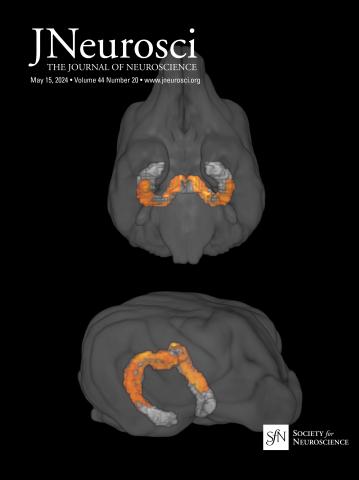Isolating brain mechanisms of expectancy effects on pain: Cue-based stimulus expectancies versus placebo-based treatment expectancies.
IF 4
2区 医学
Q1 NEUROSCIENCES
引用次数: 0
Abstract
Clinical trials, laboratory experiments, and neuroimaging studies provide converging evidence that pain is highly sensitive to expectations, whether based on the psychosocial context surrounding treatment (e.g., placebo analgesia) or transient cues that provide information about painful events (e.g., pain-predictive cues). We asked whether placebo analgesia and pain-predictive cues modulate pain through the same mechanisms or dissociable brain pathways. Forty healthy volunteers of both sexes rated pain in response to noxious heat during functional magnetic resonance imaging (fMRI) scanning. We crossed pain-predictive cues, which induce expectations for high or low pain on a trial-by-trial basis, with administration of an inert placebo cream or a control cream. Behavioral analyses revealed a significant interaction, such that predictive cues had weaker effects on pain during placebo blocks than control blocks. This interaction was accompanied by interactions in the insula, pons, and other brain regions. We also observed distinct neural substrates when we compared pure cue effects with pure placebo effects, and only predictive cues modulated responses in nociceptive regions and the Neurologic Pain Signature (NPS; (Wager et al., 2013). The only regions that were influenced similarly by both types of expectations were the rostral anterior cingulate and dorsomedial prefrontal cortex. These results indicate that cue-based expectations about stimulus intensity and placebo-based expectations about treatment outcomes are distinct, and that pain researchers should differentiate between sources of expectations. Furthermore, cue-based expectations were associated with more consistent effects than treatment-based expectations, suggesting that clinicians should be particularly mindful of how they present information about impending pain.Significance Statement This study measured the impact of pain-predictive cues and placebo effects on expectations, pain, and brain responses to noxious heat. Expectations were influenced by both cues and placebos, and we observed interactions between the two types of expectations on both pain and pain-related brain responses. We also observed dissociations in the two types of expectancy effects on brain responses and found that placebo effects were more variable than cue effects across individuals. This suggests that different types of expectations are associated with different underlying mechanisms. To maximize patient outcomes, clinicians should carefully frame both information about painful procedures and information about analgesic treatments.分离预期对疼痛影响的脑机制:基于线索的刺激预期与基于安慰剂的治疗预期。
临床试验、实验室实验和神经影像学研究提供了越来越多的证据,表明疼痛对预期高度敏感,无论是基于治疗周围的社会心理环境(如安慰剂镇痛),还是基于提供疼痛事件信息的短暂线索(如疼痛预测线索)。我们询问安慰剂镇痛和疼痛预测提示是否通过相同的机制或可分离的脑通路调节疼痛。40名健康的男女志愿者在功能性磁共振成像(fMRI)扫描中对有害热量的反应进行疼痛评分。我们将疼痛预测线索(在一个又一个试验的基础上诱导对高疼痛或低疼痛的预期)与惰性安慰剂霜或对照霜的施用进行了交叉。行为分析揭示了显著的相互作用,例如,在安慰剂组中,预测线索对疼痛的影响弱于对照组。这种相互作用伴随着脑岛、脑桥和其他大脑区域的相互作用。当我们比较纯提示效应和纯安慰剂效应时,我们还观察到不同的神经基质,只有预测性提示调节伤害感受区和神经性疼痛特征(NPS;(Wager et al., 2013)。唯一受到两种期望相似影响的区域是扣带吻侧前部和背内侧前额皮质。这些结果表明,对刺激强度的基于线索的期望和对治疗结果的基于安慰剂的期望是不同的,疼痛研究人员应该区分期望的来源。此外,基于线索的期望比基于治疗的期望具有更一致的效果,这表明临床医生应该特别注意他们如何呈现即将发生的疼痛的信息。本研究测量了疼痛预测线索和安慰剂效应对预期、疼痛和大脑对有害热的反应的影响。期望同时受到提示和安慰剂的影响,我们观察到两种期望对疼痛和与疼痛相关的大脑反应之间的相互作用。我们还观察到两种类型的预期效应对大脑反应的分离,并发现安慰剂效应比线索效应在个体中更具可变性。这表明不同类型的期望与不同的潜在机制相关联。为了最大限度地提高患者的治疗效果,临床医生应该仔细地构建关于疼痛过程和镇痛治疗的信息。
本文章由计算机程序翻译,如有差异,请以英文原文为准。
求助全文
约1分钟内获得全文
求助全文
来源期刊

Journal of Neuroscience
医学-神经科学
CiteScore
9.30
自引率
3.80%
发文量
1164
审稿时长
12 months
期刊介绍:
JNeurosci (ISSN 0270-6474) is an official journal of the Society for Neuroscience. It is published weekly by the Society, fifty weeks a year, one volume a year. JNeurosci publishes papers on a broad range of topics of general interest to those working on the nervous system. Authors now have an Open Choice option for their published articles
 求助内容:
求助内容: 应助结果提醒方式:
应助结果提醒方式:


